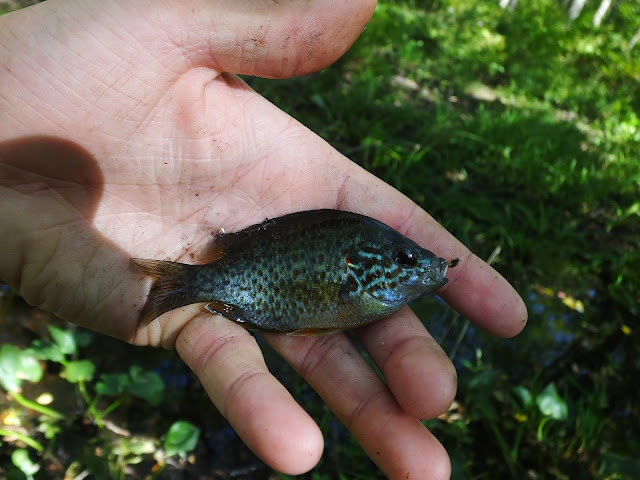There's no ignoring the fact that man has done a lot to change the state of the natural world. One way we have really messed things up is moving species from place to place, essentially playing God. One big issue I've encountered in my search for a banded sunfish is the proliferation of bluegill. They are one of the most heavily transplanted fish in North America, and although they seem like benign fish, they have upset the balance in many watersheds.
On Thursday Noah and I sampled a stream that had been surveyed before in 1989 and 2012, and only one bluegill turned up in the first survey. There hadn't been spectacular numbers of banded sunfish but there were enough to give us hope. There were also a handful of other species neither of us had caught.
I knew it was a bad sign when the first fish we both caught were bluegills. The next few hours we caught a lot of bluegills, killed most a limit each, and only caught a handful of native sunfish, those being pumpkinseeds and redbreast sunfish.
Now, I know, I am usually not the person to harvest fish I don't personally plan to eat. Hell, I don't even like the taste of fish much. But these guys had taken over a stream that is on of the handful of remaining banded sunfish strongholds in the state. So we killed a lot of non native sunfish on this outing, despite the fact that we put the tiniest of dents in their numbers because they are space hogs. Introduced species have been the prime mover in pushing banded sunfish to the very edge of their homes. To make things worse they are an easy fish to pass by. How many of you had hear of banded sunfish before my first post on the subject? Organizations and coalitions and societies have come about to protect the glamour fish. Your trouts, your salmons, your striped bass, hundreds of thousands if not millions are out there advocating for their protection. But this little sunfish; which now exists in less than a quarter of the water bodies within its range than healthy native brook trout populations do in this state; has been largely ignored by the masses. And even though I have yet to encounter one, this depresses me.
On a more positive note, meet Pip!
He's very tired, but he had to be for me to take a photo of him. Any other time he's moving too quickly for the camera. Pip is short for Pipistrello, or bat in Italian. Why? He's a black nocturnal kitten with goofy big batty ears. Our other back cat is called Pezzettino so keeping the Italian names going was a good plan. He's still a little guy and therefore requires attention, but I lucked out with a kitten who could care less about flies and fly tying materials... that's a bit rare and fortunate!
I normally don't discuss my personal life but this little guy is just too adorable not to brag about. He's cleaning himself next to me now. He ate a stink bug earlier, which he seems not to have learned from because he continued to chase them around the room and chatter at them after the awful taste went away.
I won't be writing about Pip frequently though, I hope you enjoy this one little tidbit.






Great post. Love that Pip! Sure glad he is not interested in tying your flies. Sorry to hear you are under the weather as they say.
ReplyDeleteTie, fish, write, photo and pet the cat...
Oh I wish he would tie my flies! Eating them, on the other hand, would not be a good thing.
DeleteGet better.
ReplyDeleteBluegill can be pretty good to eat. But only if the water is clean. They taste like the water when the water is bad.
There are some immigrant populations in CT who love to catch small bluegill for fish fry. Maybe there is some symbiosis to be had with restoration and bluegill removal and fish fries.
Stupid Fish Transplantation does piss me off, too.
ReplyDeleteHere is a quotation from a USGS page. The inexplicable Governments at Cross Purposes with Self is clear here:
" Impact of Introduction: In California, aggressive Bluegill outcompete native Sacramento perch Archoplites interruptus (Moyle et al. 1974; Moyle 1976). Bluegill may chase Sacramento perch away from spawning areas and out of favored places, such as shallow weedy areas, and into open water (Moyle 1976). Once in open water, the perch are more vulnerable to predation and have less available food. Introduced predatory centrarchids are likely responsible for the decline of native ranid frogs in California, California tiger salamander Ambystoma californiense populations (Hayes and Jennings 1986; Dill and Cordone 1997), and the Chiricahua leopard frog Rana chiricahuensis in southeastern Arizona (Rosen et al. 1995).
"Hybridizes with green sunfish, redear sunfish, redbreast sunfish, and warmouth (Scribner et al. 2001).
Remarks: Bluegill are commonly stocked as forage for largemouth bass in farm ponds. Because introduced California Bluegill are typically small, possibly due to a limited genetic background, the California Department of Fish and Game began introducing Bluegill from Florida in an effort to obtain a larger, faster-growing fish (Moyle 1976). Tyus et al. (1982) gave a distribution map of the this species in the upper Colorado basin."
https://nas.er.usgs.gov/queries/factsheet.aspx?SpeciesID=385
Yup. The Sacramento perch is a special fish, the only sunfish native to the Western US, and another sunfish at risk because of bluegills. Interestingly one of the most notable Sacramento perch fisheries is Pyramid Lake, a lake famed for it's huge Lahontan cutthrout trout.
DeleteI had to search for and come back to your post. I just watched the newest EPF episode in the Pine Barrens...looking for black banded sunfish....and I thought of your post. I think this is yet another species though.
Deletehttps://www.youtube.com/watch?v=o58JHd3uPJA